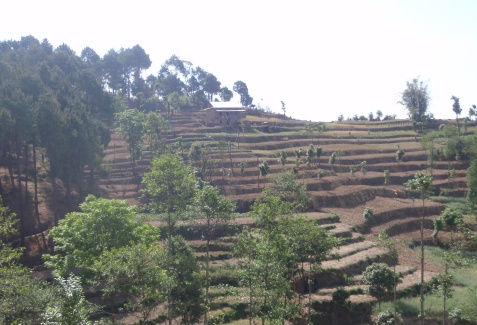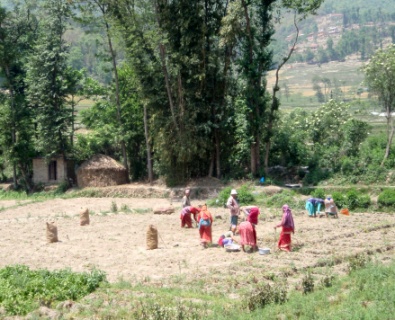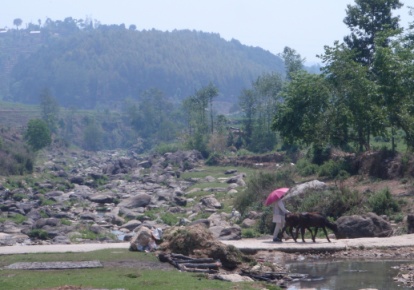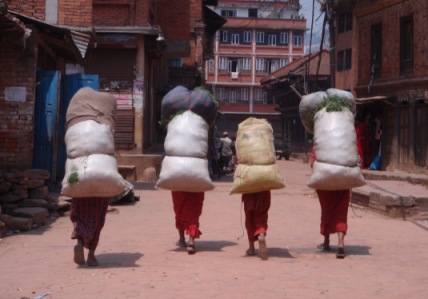EASTERN NEPAL
It was time to get out of the city and the valley. We drove east-northeast to Nagrakot which is at 8,500 feet elevation.
Nagrakot has little to offer other than its views of the Himalayas. They claim that one can see for 130 miles from there. We, however, could not see anything, including the mountains, due to air pollution. Again, we could tell that there were mountains out there, but we could not see anything more than a vague shadow. But we enjoyed being out of the busy valley, and it was a restful place to spend one night.

Terraced hillsides in Ghimire
The following morning we left on a day’s hike from Nagrakot to Dhulikel. Our trek followed a well-worn route, and we were on a trail or road most of the way. This was a beautiful trail that has been trashed – quite literally. There were large amounts of trash carelessly thrown along much of this trail. We wound our way down 3,000 feet of terraced mountainside passing through three villages along the way – Ghimire, Nala, and Banepa.
Nala was obviously an old village, and village life centers around the four-tiered Bhagwati Temple. We took a break out of the sun and watched the very slow pace of life around us. We saw only the temple, the water well, and one small shop. A few people came and went, but there was very little activity. We did see a small Buddhist temple on the edge of town as we were leaving, and a few people were working in the fields.
Banepa was a surprise to us. It was big and busy. It had paved roads, vehicular traffic, and many shops. Apparently this village/town is the supply hub for numerous outlying villages. It was too busy and noisy for our liking, and we continued on to Dhulikhel.
Dhulikhel is at 5,500 feet elevation, and it is only 50 miles from the Tibet border. Dhulikhel claims to offer views of more than 20 Himalayan peaks, but the air pollution continued to filter the view. We saw only vague shadows. We roamed around town a bit, and we enjoyed seeing the Tibetan influence. We spent only one night in Dhulikhel before heading back toward Kathmandu.

Women harvesting fields in Nala

Pastoral scene in Panauti
On our drive back toward Kathmandu the next morning, we stopped in Panauti. This is a Hindu village that was once at the crossroads of two trade routes. It was then an important village that even had a royal palace. Today, the palace is gone. Even the cremation ghats washed away in a flood. It is a quiet place that moves at a more traditional pace. It is often visited, however, by those wanting to see the Indreshwar Mahadev Temple which is believed to be the oldest temple in Nepal. We visited the temple, but we found ourselves more interested in observing the day-to-day activities of the traditional villagers.
We were tired, and we were ready to go home. We returned to a hotel in Kathmandu for a good night’s sleep before leaving Nepal.
We had enjoyed much about Nepal, but we were ready to go. Our flight, like the two previous that we had taken out of Kathmandu, was more than an hour late. We did, however, get one more glimpse of Everest above the clouds as we headed east. We flew non-stop to Bangkok, but we were too late to catch our connection to Phuket. We were flying on the budget Air Asia, and they make no allowances for missed flights, so we had to purchase new tickets. Somehow this seemed to flow naturally from the many frustrations we had experienced in Nepal.

Women carrying harvest
Although we enjoyed Nepal, we would not return. There are too many problems there – crumbling infrastructure, political unrest, air pollution, even a sensed lack of safety at times. Nepal has the natural resources and the potential to develop tourism and the income that would bring. However, they appear to be too deeply entrenched in their internal problems to see past them and recognize this potential. We wish them well as they continue to struggle along this long road that continues to inhibit their development.
Return to our Nepal page, our land travel page, or our home page.